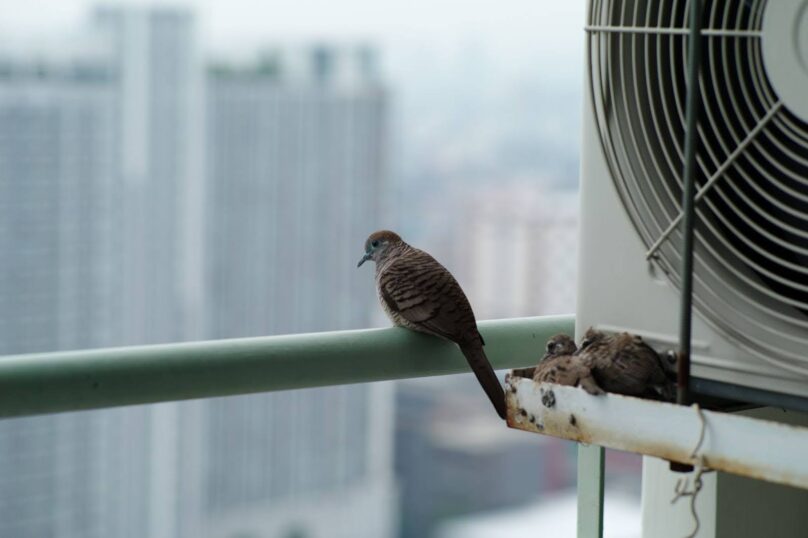
The Cost of Bird Control: What to Expect When Hiring a Pro
Birds can turn from a pleasant sight to a costly problem fast. Their droppings damage property, nests clog drains, and their presence creates health hazards. From homes to businesses, no structure is immune when birds decide to settle in. You can try to solve it yourself, but the results are often short-lived. Hiring a professional bird control service comes with a price, and understanding what that includes helps you make a more informed decision.
Why Bird Control Services Matter More Than You Think
Bird infestations aren’t just a nuisance; they bring property damage, legal issues, and safety concerns. When you ignore the early signs, costs multiply quickly. Bird control is about more than chasing pigeons off a roof. It’s about maintaining a clean, safe, and compliant property.
Property Damage From Birds Gets Expensive Quickly
Birds can cause gradual damage that often goes unnoticed at first. Nesting in gutters and vents causes water to back up, which can rot wood and rust metal. Over time, droppings eat through roof tiles, stain walls, and corrode metal structures. The cost of repairing these damages can soar into the thousands. Professional bird control helps you avoid these cascading expenses.
Birds Carry Health Hazards That Put People at Risk
Bird droppings aren’t just unpleasant; they’re hazardous. Diseases like histoplasmosis, cryptococcosis, and psittacosis spread through airborne spores. These illnesses can be severe, especially in older adults or those with weak immune systems. Birds also carry mites, fleas, and ticks that infest indoor spaces. A licensed bird control expert knows how to clean and disinfect affected areas safely.
DIY Bird Control Often Fails or Makes Things Worse
Store-bought spikes, fake owls, and homemade deterrents rarely offer lasting results. Birds adapt quickly, especially urban species like pigeons and starlings. Improper installation can lead to injuries or fines if wildlife laws are broken. Some DIY solutions even attract more pests if not appropriately maintained. Hiring a pro gives you methods that are legal, humane, and effective.
Breaking Down the Cost of Bird Control Services
Understanding what you’re paying for helps you avoid sticker shock. Costs vary depending on location, property size, infestation level, and the methods used. Professionals also offer services in packages or custom quotes depending on the job’s complexity. You’ll get a clearer idea once an inspection is done and a control strategy is planned.
What to Expect During the First Inspection
An inspection is the first and most crucial step. Pros look at nesting sites, entry points, and feeding areas. Commercial inspections typically cost between $150 and $500, depending on the property’s size and complexity. Larger structures, rooftop access, or hard-to-reach areas can raise the price. Some companies waive the inspection fee if you book services after the assessment.
Method Selection Influences the Final Price Tag
Bird control techniques include netting, spikes, wire systems, electric tracks, and gels. Each method comes with its own price range and labor requirements. Netting works best for larger areas, while spikes are ideal for fitting ledges and signs. Shock systems are discreet but more complex to install. The choice depends on your location, the severity of the issue, and your budget.
Labor and Equipment Drive Up the Bill
Professionals charge per hour, typically ranging from $50 to $100, depending on the region and their level of experience. Projects that involve ladders, harnesses, or scaffolding will naturally incur higher costs. Safety equipment, specialized lifts, and rooftop work can all increase expenses. Remote locations or tall buildings present more challenges, affecting total labor hours. This part of the cost is unavoidable for thorough and legal installations.

Cost Ranges for Common Bird Control Options
Not all control methods are equally costly. Some options are temporary, while others last for years. The choice you make should match your property’s layout and bird activity level. The following are the pricing estimates for frequently used control systems:
Bird Netting for Large or Open Areas
Bird netting is a long-term solution used in warehouses, garages, and building overhangs. It prevents birds from entering or roosting in open spaces. Netting costs anywhere from $400 to $2,000, depending on square footage. Stronger UV-treated netting adds durability but also raises the price. Professional installation ensures it’s tight, secure, and practically invisible.
Spike Systems for Narrow Surfaces
Spikes are ideal for ledges, windowsills, beams, and signs. They don’t harm birds but make landing impossible. Materials like stainless steel last longer and cost more than plastic. Installation costs range from ten dollars to $40 per foot, with additional labor charges. Maintenance is minimal if the unit is installed correctly by a professional.
Solar Panel Bird Mesh to Block Nesting
Birds love the warm space under solar panels. Mesh kits stop them from nesting and damaging the wiring. A complete installation ranges from $200 to $600, depending on the number of panels. Some providers also clean and inspect the panels before mesh placement. Quality mesh is fire-safe, corrosion-resistant, and built to withstand the test of time.
Gel Repellents and Shock Systems
Sticky gel repellents are cheap upfront but need frequent replacement. Tubes cost between $10 and $20 and last a few months. Shock tracks are more discreet and offer better long-term results. Their prices range from $500 to $1,500, depending on the surface size. They emit mild zaps that condition birds to stay away without harm.
Hidden Bird Control Expenses People Often Miss
Many property owners overlook the hidden parts of the job. These costs aren’t always listed on the first quote. However, they’re essential for lasting results and compliance with health and safety rules. Addressing these elements upfront prevents added costs later:
Cleanup and Sanitization Are Non-Negotiable
Removing droppings, nests, and debris is a messy but necessary task. The buildup contains bacteria and fungi that must be handled with care. Cleanup costs start at $100 and can exceed $1,000 for large sites. Crews wear protective suits and use EPA-approved disinfectants. Skipping this step weakens the effectiveness of your bird control setup.
Property Repairs From Past Infestations
Birds often damage roofs, wires, insulation, and siding. Once you have cleared the infestation, you’ll need to restore the affected areas. Some control companies offer light repair services or partner with local contractors to provide comprehensive solutions. Expect to pay more if carpentry or electrical work is needed. Addressing this upfront avoids repeated infestations.
Ongoing Maintenance or Monitoring Plans
Some properties require follow-up checks, especially in high-bird areas. Service contracts cover reapplication, repair, and reinspection. They usually cost between $150 and $500 per year. These plans are beneficial for businesses and buildings that experience recurring issues. Consistent upkeep keeps your bird problem from coming back.

How Bird Control Costs Vary With Bird Behavior
Bird control isn’t a one-size-fits-all service. The species on your property and how they behave have a direct impact on how much you’ll pay. Some birds are more destructive, more persistent, or more challenging to exclude than others. Their behavior affects the materials, time, and methods required to get results.
Persistent Nesters Drive Up Labor Time
Some birds return to the same nesting sites year after year. Pigeons, swallows, and starlings are known for this stubborn behavior. Once they’ve nested on your property, they’re challenging to deter without complete exclusion. Their tenacity means that professionals often need to install multiple layers of control, like netting and sealing access points. Each added step extends labor hours and raises overall costs.
Aggressive Birds Require Specialized Tactics
Seagulls and crows are more territorial and may attack when they feel threatened. These species complicate control efforts by delaying safe access for workers. Pros may need to wear protective gear or schedule work during specific hours to avoid confrontations. Additional planning, safety gear, and labor slow down the job. It drives prices higher compared to less aggressive species.
Smaller Birds Are Harder to Keep Out
Small birds like sparrows and finches can squeeze into tiny gaps and crevices. They build nests inside walls, vents, and under roofing tiles. These tight spaces are more complex to access and require more precise exclusion methods. Standard deterrents often don’t work, so installers must modify or custom-fit materials. The added time and material customization make these jobs more expensive.
Bird Intelligence Impacts Repellent Choices
Some birds, like crows and pigeons, are brilliant. They quickly recognize fake predators or adapt to basic deterrents. When simple solutions fail, pros have to install higher-grade systems such as electric tracks or motion-based repellents. Smarter species mean fewer shortcuts and more investment in complex deterrents. It increases both product and installation costs.
Protected Species Add Steps and Permit Delays
Birds like swallows and gulls are legally protected during nesting season in many regions. Pros can’t remove them or disturb nests without special permits. It can delay your project and incur additional fees for documentation and compliance. Wildlife agencies may also impose strict conditions on how and when work is done. These legal steps often increase total cost and scheduling complexity.
How Long Do Bird Control Solutions Typically Last?
Knowing how long your investment will last can shape your decision. Some control methods remain effective for years, while others require regular maintenance. The durability of your solution depends on the technique, materials, and climate.
Some Methods Outlast Others With the Right Install
Netting and steel spikes often last more than ten years. UV exposure, rain, and snow can wear out cheaper plastic components. Shock systems and gels need more frequent checks. Proper installation can double the lifespan of a system. Skipping regular inspections shortens the effectiveness of any method.
Not All Warranties Cover Wear and Tear
Warranties often exclude damage caused by weather conditions or improper maintenance. They may also limit coverage to specific areas of the property. Reading the contract closely can help you avoid surprises. Ask how long the materials are rated to last. Clear expectations reduce the risk of future repair bills.
Stay Ahead of the Problem With Bird Control
Birds move in fast, settle deep, and multiply when no one’s watching. The longer you hesitate, the more control slips from your hands until what started as a few droppings becomes an expensive overhaul. It isn’t about chasing feathers; it’s about protecting what you’ve built. Hire the right team, request a quote, and shut the door on the problem for good.
Visit the Elite Bird Management blog for expert insights.




